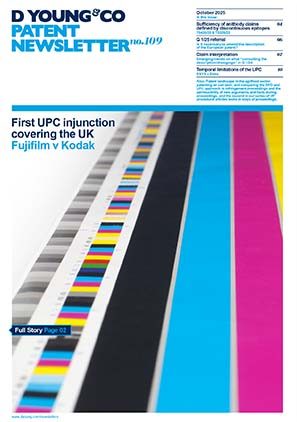T1845/14 Basell Polyolefine v Univation Technologies: insufficiency and inventive concept
In T1845/14 Basell Polyolefine v Univation Technologies, the Board of Appeal has addressed the divergent approaches to sufficiency before the European Patent Office (EPO) and the English courts. This divergent approach touches on the idea of the "inventive concept", something which permeates UK patent law but which has little basis in treaty or statute.
The patent
The patent in issue, EP 1 572 755, was for a copolymer of ethylene with alpha-olefins, with specified ranges of molar mass distribution and density and a specific short chain branching distribution (SCBD) to be determined by a specified analytic technique. The specification taught the use of composition distribution breadth index (CDBI) when synthesising the examples of the patent.
Background
Univation and Borealis opposed the patent, with the Opposition Division finding it invalid for insufficiency. The patentee, Basell Polyolefine appealed to the Board of Appeal.
Argument
In support of insufficiency, Univation and Borealis advanced a number of arguments. One such argument was that the claim could not be performed to provide one of the expressed benefits of the invention (described in the specification). In particular, they argued that the meaning of the SCBD and CDBI parameters were ambiguous, meaning that the skilled addressee was unable to select the copolymers which provided the benefit, namely a good dart drop impact strength.
This approach has, to some extent, been developed in the UK in Zipher v Markem and Kirin-Amgen v Hoescht. In particular, both discuss ‘ambiguity insufficiency’. This is a form of insufficiency which considers if the skilled addressee can tell whether he/she/it is working the invention or not. In Kirin-Amgen, the House of Lords emphasised the need to consider the nature of the invention (or inventive concept). This does not necessarily reside in the claims but may be found in the specification. In Actavis v Lilly, in relation to the doctrine of equivalents, the Supreme Court considered the term to be synonymous with 'the inventive core' of the claim, to be ascertained by focussing on the problem underlying the invention.
Univation and Borealis argued that this approach had been adopted in T 0608/07 and T 0593/09. In the former, the EPO held that "... for an insufficiency arising out of ambiguity it is not enough to show that an ambiguity exists, eg at the edges of the claims. It will normally be necessary to show that the ambiguity deprives the person skilled in the art of the promise of the invention".
The Board of Appeal disagreed. It reasoned that the ability of the skilled addressee to solve the problem in the patent (where the problem was not expressed in the claims) when seeking to carry out the invention was not a criterion for assessing sufficiency. It explained as follows:
“9.1 In landmark decision T 435/91 (OJ EPO 1995, 188), the Board, in the context of a functional definition of a component included in a claim, based its decision on the general legal principle ‘that the protection conferred by a patent should correspond to the technical contribution to the art made by the disclosure of the invention described therein, which excludes the patent monopoly from being extended to subject-matter which, after reading the patent specification, would still not be at the disposal of the skilled person’. The Board added that ‘the available information must enable the skilled person to achieve the envisaged result within the whole ambit of the claim containing the respective ‘functional’ definition without undue difficulty, and that therefore the description with or without the relevant common general knowledge must provide a fully self-sufficient technical concept as to how this result is to be achieved’ ... It is also settled case law that the same principle applies when the claim contains a parametric definition because the subject-matter cannot be expressed only in terms of structural features. What is relevant here is that the enablement of the claimed subject-matter including the functional or parametric definition present in the claim is required, not the ability to solve a problem underlying the patent in issue not present in the claim.”
It also pointed to the decisions in T 0409/91 and T 939/92 in support of its position.
Conclusion
Ultimately nothing turned on the distinction drawn by the Technical Board of Appeal as it found that the patent was insufficient because claim 1 had not been shown to be enabled across the whole range claimed. In particular, absent a recognised meaning of CDBI and given that there were two definitions in the specification, claim 1 had to be construed to cover the two definitions and their corresponding two groups of copolymers. The Board of Appeal held that, absent any further evidence from the patentee, the skilled addressee using his/her/its common general knowledge, would not have been able to carry out the invention as defined by the terms of claim 1 over its whole scope without undue burden. It followed that the patent was insufficient.
Comment
The nature of common law courts (such as those in the UK) tends to be that they will interpret legislation to a greater extent than civil law courts and tribunals. The adoption of the “inventive concept” in UK case law is such an example.
In statute and treaty, the term “inventive concept” is directed towards the unity of invention (see s.14(5) and (6), 17(6) and 26(b) of the Patents Act 1977 and Art. 82 of the EPC). However, the UK courts had used it in a different way (as described above) in at least three different contexts: entitlement, obviousness and the doctrine of equivalents.
This approach can be an aid to understanding legislation and may assist in delivering the right measure of justice. However, where it delivers divergent approaches to other jurisdictions this can also be a hindrance and source of contention as well as informing forum shopping.
T1845/14
View the Boards of Appeal of the European Patent Office PDF datasheet for the decision of 8 November 2018.
Read full decision (PDF)